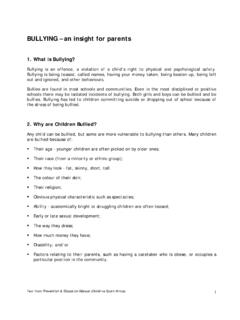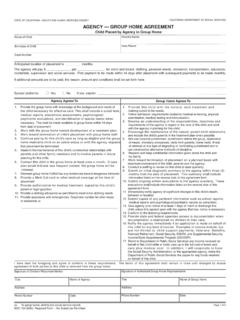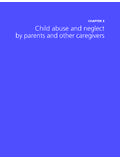Transcription of ALTERNATIVES TO CORPORAL PUNISHMENT for pdf
1 Text from Prevention & Education Manual (Childline South Africa) 1 ALTERNATIVES TO CORPORAL PUNISHMENT 1. What is CORPORAL PUNISHMENT ? CORPORAL PUNISHMENT can be described as any physical action that hurts a child in the name of discipline . This could mean: hitting, slapping, pinching, pushing, shaking and kicking; depriving the child of food or rest or movement; forcing chillies, washing-up-liquid or other irritating substances in a child s mouth or anywhere on his or her body; and/or forcing them to sit or stand for any length of time. Emotional PUNISHMENT is any action of adults to deliberately cause emotional distress to children in the name of discipline.
2 This would include PUNISHMENT where anyone encourages others to hurt a child emotionally. Emotional pain of this nature includes: an educator calling on the class to ridicule a fellow learner; the distress caused by threats, and other hurtful, frightening or humiliating and shaming words; screaming or shaking a fist at a child; shutting a child into a dark cupboard; unfair discrimination of a child; the withdrawal of love, affection and attention; a refusal to communicate or respond to the child over a significant period of time; and/or encouraging others to isolate a child and ignore him or her.
3 The inflicting of intellectual pain can also be used as a PUNISHMENT . A common intellectual PUNISHMENT is: insisting that a child agrees with a statement that he or she does not accept as being true; forcing a child to attempt tasks that are beyond his or her intellectual capacity (usually combined with humiliation); and/or forcing a child to do boring, repetitive and meaningless tasks. Text from Prevention & Education Manual (Childline South Africa) 22. Why Physical PUNISHMENT is not Acceptable It teaches children that hurting others is okay.
4 Children frequently learn from adults how to behave and interact with others, and may internalize the guidelines regarding acceptable and unacceptable behaviour. It breaks down the relationship between parent and child or teacher and child. Children need to be able to trust parents and teachers to care for them and not to hurt them. Physical PUNISHMENT strains this relationship. Children may come to believe that they deserve to be hurt- creating a low self-esteem and a poor self-concept. Children may become anxious or afraid of adults. They may also present as being angry, uncooperative and resentful.
5 It may damage children physically. Children may have suffered permanent harm such as deafness from a strike to the head or brain damage or death from being shaken. Bones may have been broken from having an arm twisted and internal organs can be damaged as a result of blows. It opens the door to physical abuse. Physical abuse of children promotes the notion that it is okay to hurt children. When parents or teachers are angry or distressed it is easy to overstep the limit that parents or teachers set themselves. The smack may develop into a blow or a beating and the child may be seriously hurt.
6 Therefore it is safer to set boundaries that promote a non-violent form of discipline that promote no smacking or physical hurt. It is not effective in the long term Hurting children does not work well in changing behavior permanently because it does not change the child s underlying attitudes and values. The child does not learn self- control, only permissiveness, how to respond to the control of others, or how to lie and hide what they are doing so as to avoid PUNISHMENT . Text from Prevention & Education Manual (Childline South Africa) It damages children s development Children who are sad, confused anxious or angry cannot concentrate on the work or play they need for developing their potential.
7 Research shows that children who are disciplined at home in alternative ways, without being hurt, do better at school than others whose parents use physical PUNISHMENT . This is due, in part, to the fact that parents who use alternative and positive methods of discipline teach their children more communication and problem-solving skills. 3. ALTERNATIVES to CORPORAL PUNISHMENT Discipline is an ongoing process and results cannot be achieved on the basis of one incident. Discipline can also not be instilled through a once-off response by parents and caregivers to a single incident of negative behavior.
8 Since we have established that CORPORAL and emotional PUNISHMENT is not an acceptable form of PUNISHMENT , what are the ALTERNATIVES ? Give praise If you praise children when they obey or do things well, this encourages them to model their behavior on positive reinforcements. Praise also encourages them to learn self-discipline. Praise costs nothing and if you choose to reward them by treating them, these treats could range from telling the child a story at bed-time to allowing the child to visit a favourite friend or relative.
9 Lead by example. If a child is not allowed to use dirty language or to swear, neither should you. Basically, practice what you preach! Be realistic. There is no point in punishing a baby for crying because he or she is hungry, or a two year old who runs into the road in front of cars because this is what can be expected from children at different ages. Instead, keep children safe by removing the possibility of physical danger- make sure your baby can t reach the fire or the paraffin bottle or hold your child s hand when you walk on the road.
10 Text from Prevention & Education Manual (Childline South Africa) Restorative Justice Children can often provide answers that will result in an acceptable compromise so encourage them. For instance, a useful technique with most children is used in restorative justice practices (which are well-known in African culture). Restorative justice involves both victim and offender in a meeting aimed at planning a way to repair any harm caused. In addition, some set plans to prevent future misbehavior by all concerned. These techniques have been successfully used by school governing bodies seeking alternative punishments in the school system in South Africa.










